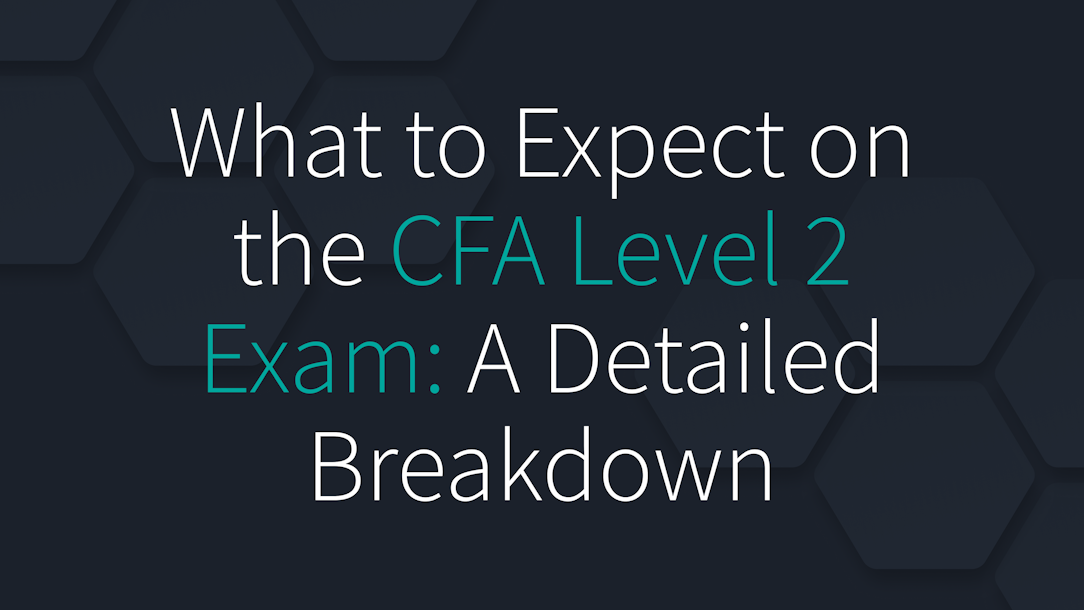
What to Expect on the CFA Level 2 Exam: A Detailed Breakdown
The CFA Level 2 exam is a demanding, application-based challenge, but with the right strategy, it is absolutely conquerable.
The CFA Level 2 exam is often considered the most challenging stage of the CFA journey. It shifts from the broad foundational concepts of Level 1 to a deeper, application-focused approach that tests your ability to analyze and interpret complex financial scenarios. Understanding the exam’s format, structure, and best preparation strategies is crucial to success.
This guide will break down everything you need to know about what to expect on the CFA Level 2 exam, ensuring you walk into test day fully prepared.
CFA Level 2 Exam Format and Structure
Unlike Level 1, which consists of standalone multiple-choice questions, Level 2 introduces item sets—short case studies followed by multiple related questions. This format assesses your ability to apply financial concepts rather than just recall information.
Key Features of the Exam
- Computer-Based Testing (CBT) – Administered in two sessions
- Item Set Format – Each vignette has 4-6 multiple-choice questions
- Exam Duration – Split into two 2-hour 12-minute sessions
- Total Questions – 88 item-set questions across both sessions
Time management becomes essential, as each vignette requires careful reading before answering the associated questions.
Key CFA Level 2 Topics and Their Weights
The CFA Level 2 curriculum is structured across 10 topic areas, but not all topics are weighted equally. Some carry more importance, requiring extra focus during preparation.
Topic Weight Breakdown:
- High-Weight Topics: Equity Valuation, Financial Reporting & Analysis, Fixed Income
- Medium-Weight Topics: Derivatives, Portfolio Management, Corporate Finance
- Lower-Weight Topics: Alternative Investments, Economics, Ethics, Quantitative Methods
Since the exam tests how different financial concepts interact, expect multi-topic vignettes that require the cross-topic application of knowledge.
The CFA Level 2 Item Set: What to Expect
Each vignette is a detailed case study that presents financial data, valuation models, or ethical dilemmas. Candidates must extract relevant information and apply concepts to answer related questions.
How to Approach Item Sets Effectively:
- Skim the Questions First – Get an idea of what the vignette is testing before reading in detail.
- Focus on Key Data – Not every detail matters. Train yourself to identify essential information.
- Manage Your Time Wisely – Avoid spending too much time on a single vignette.
These case study-style questions require interpretation, analysis, and logical reasoning, making them significantly different from the direct recall-based approach of Level 1.
Common Traps and Challenges Candidates Face
The Level 2 exam is designed to be tricky. Many candidates struggle with time management and misinterpretation of financial data within vignettes.
Key Challenges
Overanalyzing Item Sets – Some vignettes contain extra details to test whether you can filter out unnecessary information.
- Time Pressure – Avoid spending too much time on a single question; keep moving to maintain pace.
- Complex Financial Reporting Calculations – Topics like intercorporate investments and pension accounting require precise calculations under time constraints.
- Ethics Scenarios – The CFA Ethics section becomes more nuanced in Level 2, requiring careful reading to differentiate between right and wrong choices.
To succeed, practice timed CFA Mock Exams Level 2 and train yourself to think critically rather than rely on memorization.
CFA Level 2 Study Strategy and Preparation Plan
Passing CFA Level 2 requires a structured and disciplined study plan. Here’s how to tackle it effectively:
Study Timeline
- First 3 Months – Focus on core readings and concept mastery.
- Middle 2–3 Months – Shift to solving item sets and applying knowledge.
- Final Month – Prioritize CFA Mock Exams Level 2 and refine weak areas.
Best Study Techniques
- Practice, Practice, Practice – Solve 1,500+ practice questions to develop speed and accuracy.
- Simulate Exam Conditions – Take full-length mock exams under timed conditions.
- Review Mistakes Thoroughly – Every wrong answer is a chance to improve—keep an error log.
- Refine Ethics Understanding – Ethics remains a crucial scoring area, so don’t overlook it.
Mastering Level 2 requires a combination of conceptual depth, analytical skills, and time management.
Exam-Day Tips: How to Perform Your Best
The way you manage your time and mental focus on exam day can make a huge difference.
Tips for Exam Success
- Read Questions Carefully – Avoid rushing through item sets and missing key details.
- Don’t Get Stuck on One Question – Move on and come back if needed.
- Use the Process of Elimination – Narrow down choices systematically.
- Stay Calm and Confident – Trust your preparation and avoid second-guessing.
A clear exam strategy combined with strong preparation will give you the best chance to pass.
Conclusion
The CFA Level 2 exam is a demanding, application-based challenge, but with the right strategy, it is absolutely conquerable. Understanding how to break down vignettes, apply cross-topic knowledge, and manage time effectively will put you in a strong position for success.
At Salt Solutions, we provide expertly designed study materials to help you master every aspect of the CFA Level 2 exam. Whether you’re preparing for the CFA Level 1 Exam, navigating the complexities of the CFA Level 2 Exam, or tackling the final hurdle of the CFA Level 3 Exam, our resources are built to maximize your efficiency.
Explore our comprehensive CFA Exam Study Material Guide & Notes to ensure your preparation is thorough, strategic, and exam-ready.